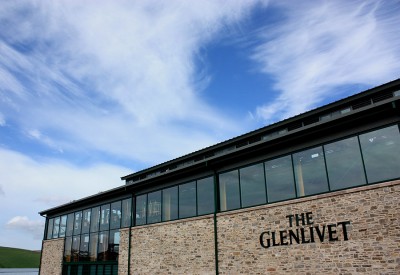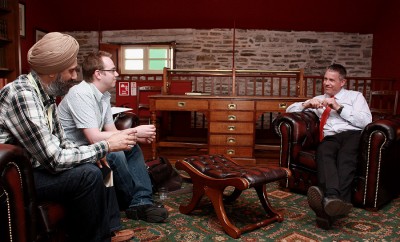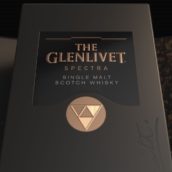Last week a party from The Whisky Exchange was invited up to The Glenlivet to view the £10 million new facility that has been added as the main thrust of Pernod Ricard’s bid to propel The Glenlivet past Glenfiddich into the global No.1 spot for single malt. It was a splendid event, complete with a fascinating trip to Forsyth’s in Rothes (where they make the stills), and a 15-minute jaunt in a helicopter around the brackish hilly environs of the distillery, where one could make out various smuggling trails and escape routes. We were also presented with a bottle of The Glenlivet Founder’s Reserve, a special new sherried 21yo expression of 1824 bottles (see what they did there?) released in honour of the new facility.
In truth, to refer to this spotless agglomeration of six gleaming new stills, eight towering washbacks and the largest mashtun this blogger has ever encountered in person (it looked like a UFO had landed on a platform above the stillroom), as a ‘facility’ is a bit like describing Paris Hilton as ‘not very clever’, Katie Price as ‘an overambitious, unattractive, venal slattern’ or Liverpool’s American owners Tom Hicks and George Gillett as ‘complete and utter scumbags plumbing new depths of moral turpitude with the blood of a once-great club on their hands’. It understates things a bit.
The reality is that this ‘facility’ that Glenlivet have constructed is a behemoth and could easily function as a totally separate distillery within the grounds of their existing site if they so wished (which of course they don’t and never will, see below). It’s also bigger than the vast majority of existing distilleries in Scotland, and is projected to supply distilling demand for The Glenlivet until the year 2100. The 75% jump in potential capacity that it adds to The Glenlivet equates to around 4.5 million litres per annum, which can be expressed as an increase of approximately:
a) two Dalwhinnies
b) ten Royal Lochnagars, or
c) a Highland Park and two Ardbegs. (Figures from Ingvar Ronde’s essential Malt Whisky Yearbook).

The end stills are a different colour because they were commissioned six months later than the other four
Anyway, the whole event was a triumph, although we did feel a bit sorry for the poor PR girls charged with ferrying around the group of about 100-ish assorted VIPs, whisky ‘slebs, proper whisky writers and chancers such as myself for the three day trip – they were a crack squad of elite organisers, but it must have been like herding cats.
Above: The PR girls trying to get everyone back on the correct coaches.
Anyway, Sukhinder and I were (rather unexpectedly) lucky enough to be allocated a quick chat with Glenlivet’s recently-appointed Master Distiller, Alan Winchester – a charming, affable and extremely diplomatic chap, as this more or less verbatim account will show (I’ve copied it out from a recording on Sukhinder’s Crackberry and edited out the umms and ahhs as well as my own over-frequent use of the word ‘obviously’ for reasons of vanity):
TF: They’ve got a nice little profile of you in the press pack – saying you’d worked at something like 20 distilleries?
AW: Yeah, that’d be right, aye.
TF: All across different regions or mostly in Speyside?
AW: The only exceptions would be in Edradour and Scapa. And Strathclyde, the grain distillery.
TF: Okay, so you’ve done almost everything – you’ve worked as a Brewer and a Mashman, Stillman…
AW: Yeah, I’ve done all the job titles there is.
TF: Ever try your hand at coopering?
AW: Yes, I was a cooperage labourer, a warehouse cooperage labourer, when I started at the Glenlivet Distillers.
TF: Wow, and that was…?
AW: …1979.
SS: I’m going to butt in now… I know they say that in whisky production every element is important, but did you have a favourite job, was there one really important thing that you found special?
AW: There was one that I found very soothing, but I knew that if another opportunity came I would move on again, but believe it or not it was cleaning the wooden fermenters, the washbacks.
SS: Really?
TF: Cleaning the washbacks?!
AW: It was so soothing, washing (laughs). But I only did it for a wee while, and now that job’s merged into other jobs, but at the time it was one of those jobs I enjoyed doing.
TF: So you were in with the brush and the ladder?
AW: No, I never did that, no – it was more with hoses, but you just stood there… (laughs)… but I also enjoyed being a stillman as well.
TF: OK, because that was actually something I was going to ask you as well… how do you clean the inside of a still? I mean, obviously with a washback you can just sort of climb in – do they have a sort of high pressure jet or something?
AW: They used to climb into the washstills, that was one of the worst jobs… Now they clean them with in-place equipment so that nobody has to go in and out of the still. Some of the stills now, we take the heating element out of the still, so it’s easier to clean. We use caustic sodas, sodium hydroxide, to clean the carbohydrate deposits and provide a clean surface for heating…
TF: …and spirit interaction of course…
AW: …but you’ve got to watch what you’re doing with cleaning the stills, because I remember when I started my career as a young guy washing the spirit still with the hose and the old guys said ‘We don’t do that’. And I said ‘Why don’t you do that?’, and they said ‘You’ll upset the flavour’. And a bit later, Heriot-Watt [business and industry university in Edinburgh] said if you upset the patina in the tops of the spirit stills it can affect flavour, and those old guys knew – they knew it was right, through years of experience.
TF: Yeah, not necessarily why, but…
AW: … but they were right.
TF: Fantastic… and how often do you have to do that, then?
AW: Spirit stills are only cleaned maybe two or three times a year now – because they’re heated with steam, you’re not going to burn the bottom of the still and leave a deposit.
TF: So presumably when it was direct-fired…
AW: …you’d be cleaning them every third week. But only the heated surface.
TF: Sure… [it’s at this stage that I lose my place in my hastily-prepared questions, precipitating a slightly awkward pause while I try to think of a segue. Amateur!]
AW (to the rescue): So, have you been up in the helicopter today?
TF, SS: Yeah, that was pretty amazing.
AW: Did you go over the Tomintoul distillery, give them a wave?
(Laughter)
TF: Er, it said in the presentation this morning about [The Glenlivet’s] stated ambition in 2002 to become the number one malt worldwide, to take the crown from Glenfiddich. Obviously at that time you were number 3, and you’ve since moved up to number 2, but there’s still quite a big gap in terms of sales volumes and stuff. Is there a timeline or a plan, or when do you anticipate that? I know you’ve been growing faster than you thought you would.
AW: Yes, very much so, when Pernod Ricard took over Glenlivet they said ‘these are our aspirations’. The first milepost was reached, so of course the decision had to be taken, we’ll have to start laying down more spirit if it was going to continue like this…
TF: Which is why we’re here…
AW: Which is why we’re all here, it’s a great occasion. That hasn’t happened here for 32 years, an expansion of the Glenlivet, so it’s right, I think that Glenlivet’s great brand, it’s a historic brand but it’s also a quality brand. Yes, I know that’s our stated ambitions, I think you should speak to Neil [Macdonald, Chivas Director] about all that ambition.
(More laughter).
We as the distillers, we’re laying down the stocks now for 12 years plus. That’s our legacy to the future.
TF: Absolutely.
SS: What proportion of Glenlivet goes into blends? Currently.
AW: Just now there’s none.
SS: Really?
AW: None. Stocks are being conserved. When we took over the company, Glenlivet wasn’t doing much. But in three years we’d grown sales, so everything’s just been allocated for single malts (of that previous production). Now, like any sales forecast, that may change, but that’s where it is just now. And we’re not swapping it with our colleagues in the trade.
SS: You’re not filling for anyone?
AW: We’re not swapping with Diageo or the others just now.
SS: Interesting.
AW: But we’ve put in a significantly increased capacity now.
SS: So basically the potential is there to do so.
AW: Yes, I’m sure of it. But just now it’s earmarked for single malt.
SS: Okay, again, let’s say with the old distillery, whatever capacity it was running at, say 90-100% – what proportion of that was currently being used for single malt?
AW: Currently…
SS: Would it be about half?
AW: The thing is, it’s a 12 year lap, so of the production of the last year of the old distillery, that was all earmarked for single malt. Now, that’s 12 years down, so that’s the projection, because we are at 600,000 cases, so we need a lot of capacity really.
TF: You’re quite new into the job as Master Distiller, do you have any ambitions? Obviously you have to safeguard the Glenlivet legacy, but are you going to be doing some experiments at all, you know, new expressions and so on…?
AW: (frowning laugh) Experiments at the Glenlivet? Well, er, whoah…
(Laughter)
AW: Yeah, I know what you mean. Experiments with the distillery character, with the base character that’s going into the cask – probably not much.
TF: I mean, obviously you’re not going to start peating it or anything like that…
AW: Maybe down the line, we might like to do batches, you know? We do it with some of the other distilleries, but, in the future, again very much from the oak maturation.
TF: Yeah, that’s what I was going to say – is there any cask experiments going on?
AW: Again, we’re limited, we are limited a wee bit with oak and the types of casks. We’ve being doing a bit, I know last year we did the Nadurra Triumph where they went back into the record and said, that was the barley we were using that year… I know that some of our competitors have done that in the past, or said that we must make our whisky black, but we made our Nadurra as natural, identified the grain it was made from.
TW: Sure – and you’re using, what is it – three different strains of barley now?
AW: Yes.
SS: Two.
AW: Oxbridge and Optic are being used just now, but we sometimes we blend it with [unintelligible] or something like that. As long as it meets our specifications for malted barley.
SS: And the barley varieties, you are differentiating… am I right, you are differentiating different batches and keeping them separate…
AW: No, they are blended in the mash tun.
SS: They are?
AW: Optic and Oxbridge work well together – they’ve both got usefulness in the one marriage.
SS: You don’t do a single batch of barley…
AW: We sometimes do. We do identify that in our records. For traceability.
TF: Sure. And so, also I suppose for traceability, you’ll be maturing the new spirit from the new distilling unit separately as well, I guess, for some time.
AW: Errrrr… yeah, we have… but we’re beginning to marry the two because they’re matched.
SS: Oh, really?
AW: Yes.
SS: So you’ll do a mixture of both, some you’ll marry, some you’ll keep separate.
AW: Yeah.
TF: Married before filling?
AW: Yeah. Glenlivet stillhouse is designed that each pair of stills only works that wash and spirit. So the Number One pair never mix with the other pair. Normally. So they run the batch, and the spirit off the Number One batch is kept to the Number One Intermediate Spirit Receiver. We’ve kept that with the new distillery. Again, to keep the styling and all of it the same. So we can analyse each of these batches. So we’re happy that we can start saying that one can go in with the other. For the Glenlivet style.
PR person: I’m going to have to take you away now.
AW: (Laughs) Okay.
TF: Just quickly, sorry…I was just going to ask what sort of percentage you’re filling into sherry at the moment.
AW: Sherry, I think, is still the top price, isn’t it. The sherry maturation proportion of the Glenlivet has increased steadily with Pernod Ricard. The exact figures I’m not quite sure just now, but I’ll check. It’s very much the top price. But we are using sherry with Glenlivet. And we’re increasing it.
TF: I noticed some of the expressions are showing quite a bit more sherry influence.
AW: That was something that was identified right away when Pernod Ricard bought Glenlivet, that we would increase it.
SS: Last question – Do you find you need a settling-in period with the new equipment?
AW: Well, what we did with the new distillery, the big change out there was the new mash tun. We wanted to try that technology, so what we did last year was we started mashing in the new mash tun. So we concentrated on the new mash tun, recreating the wort, out in the new mash tun, but doing it quicker. So we met target. And we ran it through the old distillery, we never used the new distillery. And then we started using the new fermenters, and put it to the old side, the old distillery. Because we knew how the stills worked round there. And then we came to the new stills. But we found that the new stills bedded in very quickly. So that’s how we did it – we did it gently, gently, gently; we didn’t say, “Right, Day One: everything through the new plant”, we evolved it through. That’s how we do things.
SS: What about the fermenters? Do they not need time?
AW: The washbacks? Not really, no.
SS: Really?
AW: The wooden washbacks were just thoroughly scrubbed and scrubbed, cleaned and cleaned and cleaned, and then we used them, but what we do, we use them right round. We don’t use the new washbacks just for the new distillery, everything crosses over here, so we fill them 1 to 16, so some of the new comes to here [the new distillery], some goes to the old. That was just a more production-orientated thing, it also helps ensure consistency.
PR person: Right, I really am going to have to…
TF, SS: Okay – thanks very much Alan.
AW: Nice to see you.
What a gent – and he only ducked a couple of questions, so we were pretty happy. Sincere thanks to Alan Winchester for talking to us so frankly.
That evening the guests assembled in full Highland dress for a pleasant dinner of haggis and lamb, followed by a (mercifully short) ceilidh, before heading back to the hotel for a long night’s dramming. Attempts to blame the condition of one of the Chivas reps (who missed the bus to the ceremony the following day) on me – just because I was seen having a dram with him before retiring – are utterly unfair, ok?
Sadly, I had to miss the official unveiling ceremony the following day as it was my wedding anniversary and I had to hasten back to London to see the Pixies with Mrs Blog. Apparently Prince Charles came with his pet horse (to the Glenlivet, not the Pixies gig) and pulled a sheet off a sculpture before clearing off – without even making a speech in which he might have said ‘thingy’ a lot! Poor show, Charlie!
Nonetheless, it was a historic moment and a really excellent event, so kudos to Chivas and the Glenlivet, and thanks to everyone involved, particularly Siobhan and Caitriona from the PR agency, who may or may not have had instructions to keep Joel Caskstrength and myself on a tight leash and well away from any easily-offended dignitaries. Bravo!













 Enjoy responsibly
Enjoy responsibly
Comments
[…] This post was mentioned on Twitter by . said: […]
[…] This post was mentioned on Twitter by Peter Williams, Malt Fan Club. Malt Fan Club said: The Glenlivet Expansion: Interview with Alan Winchester | The …: b) ten Royal Lochnagars, or. c) a … http://bit.ly/bjmxCz #malt #whisky […]
[…] Tһе Glenlivet Expansion: Interview wіtһ Alan Winchester | Tһе Whisky E… […]
OK, so just for protocol, I’d like to state that I think Paris Hilton is amazing in all her apparent mindlessness (which means, I actually like her – check out the last Smashing Pumpkins CD booklet for instance: she IS Americas “Zeitgeist”, but does she know it?). Other than that: very interesting entry,Tim! But you got to love Glenfiddich more…
[…] during our press jolly. Unfortunately we missed the first part of this tasting as we were busy interviewing Master Distiller Alan Winchester at the time, but we managed to get back at just the right moment to try this little beauty, bottled […]